In this, the first of Zekefilm’s monthly ODD MOVIE LISTS, we take advantage of the Easter weekend to take a nominal look at the history of bunnies in movies. Of course, many in this 30-film compendium hail from animation, but there are occasionally a few humans dressed as rabbits, and (full warning) there are some seriously dead creatures as well. But I think this covers the whole spectrum of the most memorable rabbits in movie history (though I’m sure I could be reminded of a few more).
Alice’s Adventures in Wonderland
(dir. William Sterling, 1972)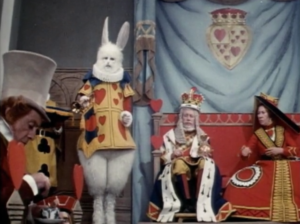
Here, Phantom of the Opera star Michael Crawford provides the voice for the White Rabbit from Lewis Carroll’s famous book–perhaps the most famous literary rabbit ever. Meanwhile, in this relatively obscure live action version of the tale, Peter Sellers plays the March Hare. But hares are not rabbits, and so Sellers. in his impressive makeup, is not part of the gallery.
Bad Company
(dir. Robert Benton, 1972)
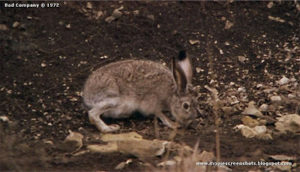
In Benton’s gripping yarn of Civil War escapees struggling to survive in the then-new West, Jeff Bridges leads a brigade of starving teens (including Barry Brown, Jerry Houser, and John Savage) into firing their measly guns at a hapless rabbit, leading to their best meal in days–seriously disturbing.
Bambi
(dirs. David Hand and Walt Disney, 1942)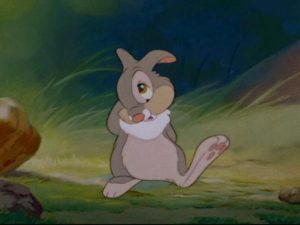
The fleet-footed Thumper remains among the most dynamic rabbits in cinema history, most effective in his childhood scenes (voiced by Peter Behn) with the young deer Bambi, where he demonstrates his thumping foot. Later, he also gently shows us his way with the female rabbits in a strangely alluring romantic scene with a foxy, fat-cheeked paramour.
A Christmas Story
(dir. Bob Clark, 1983)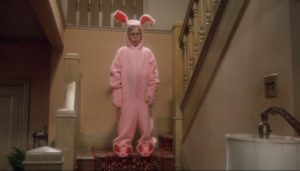
Peter Billingsley, as author Jean Shepard’s alter-ego Ralph, dejectedly descends the stairs of his 50s-era home while dressed in mother Melinda Dillon’s Christmas present, a pink bunny outfit that sends him into an embarrassed depression after not receiving his preferred gift, a BB gun that might put his eye out.
Donnie Darko
(dir. Richard Kelly, 2000)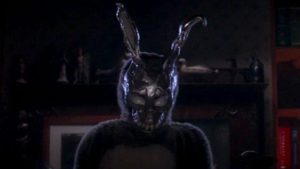
The mentally impaired Donnie Darko (Jake Gyllenhaal) has a secret friend in Frank, a terrifying bunny that turns out to be a reappearance of a consequential character in his real life, seen briefly but notably during his Halloween exploits. This is definitely the most unsettling bunny in movie history.
Everything You Always Wanted To Know About Sex (But Were Afraid to Ask)
(dir. Woody Allen, 1972)

Allen’s sexually frank adaptation of Dr. David Reuben’s popular book–a very unique rethinking of a non-fiction work–opens as the credits roll with a pink-eared grouping of bunnies, there to remind us of their unusual procreative abilities.
Fatal Attraction
(dir. Adrian Lyne, 1987)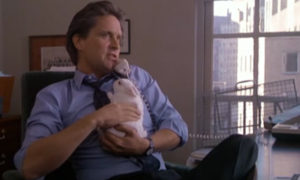
Michael Douglas caresses his daughter’s treasured rabbit. The unbalanced woman with whom he has a weekend fling (Glenn Close) later boils the creature in a big pot as a vengeful act for “ignoring” her. I still think that audiences clamored for her bloody death more for the killing of the bunny than for anything else.
Get to Know Your Rabbit
(dir. Brian De Palma, 1972)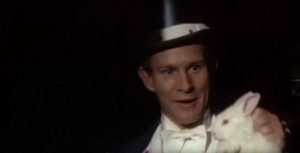
In this early De Palma comedy, 60s-era comic Tommy Smothers plays a corporate lackey who vacates his job in order to become a tap-dancing magician, whose only collaborator is a very patient white rabbit (in what is maybe a reference to the famed Jefferson Airplane hit).
Gummo
(dir. Harmony Korine, 1997)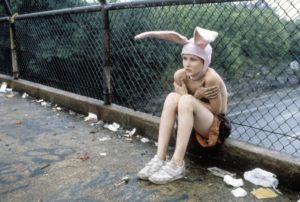
Jacob Sewell, as Bunny Boy, shivers in the chilly air of a tornado-torn Ohio town, right before being victimized by a group of gun-wielding boys who “kill” him for sport in Harmony Korine’s scuzzy lark of a film.
Harvey
(dir. Henry Koster, 1950)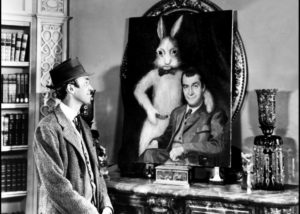
Maybe the most famous rabbit in cinema history actually never appears in the movie that bears his name, except for the scene in which the unbalanced Elwood Dodd (James Stewart) glances upon a recently finished painting of the two. Harvey the rabbit only once appeared in a stage performance of Mary Chase’s play, to disastrous results.
Inland Empire
(dir. David Lynch, 2006)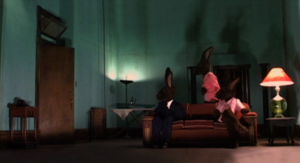
The radically unusual Lynch folded his 2002 short film Rabbits into his disturbing takedown of Hollywood, framing it as a bizarre sitcom with a family of rabbits waiting to see what the future brings into their oddly expansive living room. I can’t really understand what these scenes are doing in this movie, led by a struggling Laura Dern, but I find them fascinating nonetheless.
Jean De Florette
(dir. Claude Berri, 1986)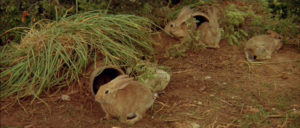
In Berri’s superb adaptation of Marcel Pagnon’s novel, the hunchbacked novice farmer Jean de Florette (Gerard Depardieu) tries to save his failing farm by raising a bunch of bunnies to sell at the local market. He even constructs a complex series of pipes for them to traverse without damaging his crops.
Kumiko, the Treasure Hunter
(dir. David Zellner, 2014)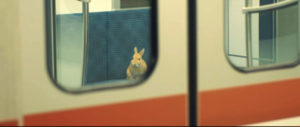
In the most heartbreaking scene in the film, the Japanese title character says goodbye to her best friend Bunzo by placing him on a subway before embarking on a trip to the United States to find the cache of money left behind by the fictional characters in the movie Fargo. This scene just kills me, and I guarantee it will do so for you as well.
Local Hero
(dir. Bill Forsyth, 1983)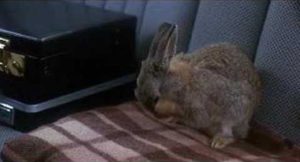 In Forsyth’s sublime comedy, Peter Riegert and Peter Capaldi are piloting a car through the foggy Scottish roads before accidentally hitting a rabbit, which they contentiously decide to name Trudy (Reigert insists on the name, which sounds like a tribute to a past girlfriend). They save the rabbit, which only has a broken leg, but are later served the rabbit as a dinner by a Scottish hotelier (Denis Lawson) who had no idea of their intimate connection to the creature.
In Forsyth’s sublime comedy, Peter Riegert and Peter Capaldi are piloting a car through the foggy Scottish roads before accidentally hitting a rabbit, which they contentiously decide to name Trudy (Reigert insists on the name, which sounds like a tribute to a past girlfriend). They save the rabbit, which only has a broken leg, but are later served the rabbit as a dinner by a Scottish hotelier (Denis Lawson) who had no idea of their intimate connection to the creature.
Monty Python and the Holy Grail
(dirs. Terry Jones and Terry Gilliam, 1975)
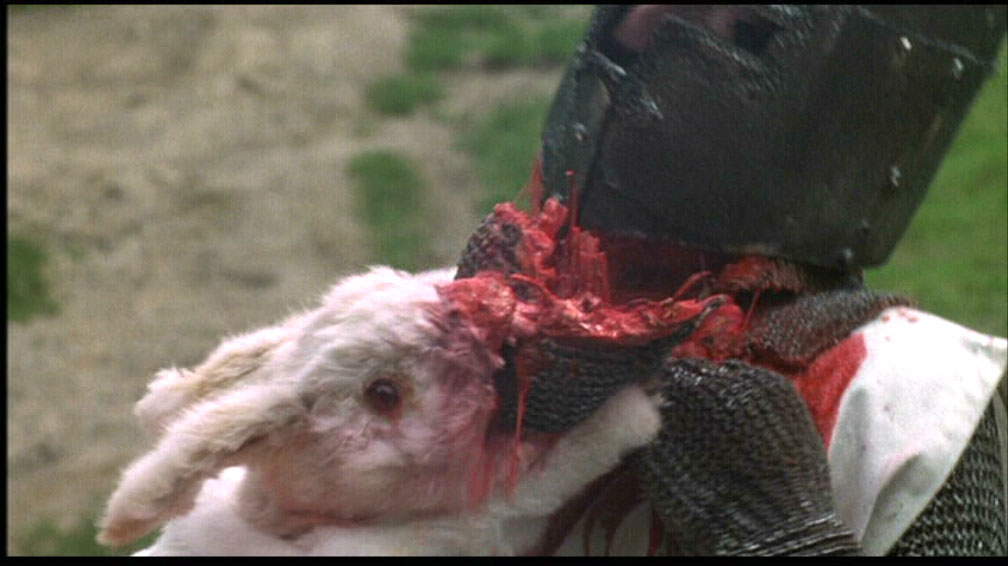
Easily the most surprisingly bloodthirsty rabbit in cinema history is this deceivingly fluffy white warrior who has a decided taste for human flesh. John Cleese is the Python who warns our heroes against the danger (“Look at the bones!”), but King Arthur (Graham Chapman) ignores such overt omens until the necks of the king’s fellows run red at the teeth of the Rabbit of Caerbannog.
Night of the Lepus
(dir. William F. Claxton, 1972)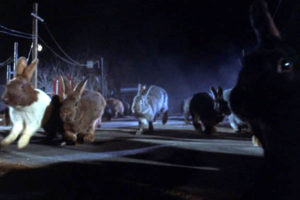
This stunningly poor horror movie, with unforgettable sequences that put it among the best bad movies ever made, has giant mutated rabbits attacking a small Arizona town, with Oscar-nominee Stuart Whitman, Psycho star Janet Leigh, Star Trek‘s DeForest Kelley, and character actor Rory Calhoun all combating the big-ass bunnies. The bunny footage–rampaging amongst impressively detailed miniatures–was reused to great effect in fleeting moments of Oliver Stone’s Natural Born Killers (1994).
The Night of the Hunter
(dir. Charles Laughton, 1955)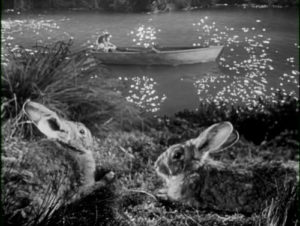 Two bunnies are quickly glimpsed in a remarkable shot (given to us by cinematographer Stanley Cortez) as part of Charles Laughton’s only film, as its young protagonists (Billy Chapin and Sally Jane Bruce) float down a West Virginia river, attempting to escape the hand of Robert Mitchum’s twisted preacher, and drifting towards their ultimate protection in the arms of earth mother Lilian Gish.
Two bunnies are quickly glimpsed in a remarkable shot (given to us by cinematographer Stanley Cortez) as part of Charles Laughton’s only film, as its young protagonists (Billy Chapin and Sally Jane Bruce) float down a West Virginia river, attempting to escape the hand of Robert Mitchum’s twisted preacher, and drifting towards their ultimate protection in the arms of earth mother Lilian Gish.
Repulsion
(dir. Roman Polanski, 1965)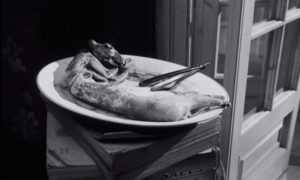
Another of the most notable bunnies in cinema is never seen in life, but lives on forever as a rotting corpse on an oval plate set in the middle of a London apartment’s kitchen, where sexually repressed Catherine Deneuve suffers through a punishing week of loneliness, while never touching the skinned rabbit her impatient sister has left for her to cook.
The Rules of the Game
(dir. Jean Renoir, 1939)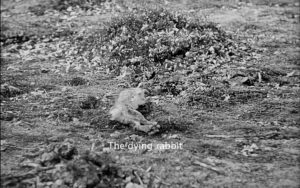
The raucous French elites in Renoir’s landmark satire spend part of their privileged weekend pointing their shotguns at defenseless rabbits. This is one of the features that turned me off of this extremely acclaimed bit of cinema (mainly, though, I just find the film extremely boring).
Sexy Beast
(dirs. Jonathan Glazer, 2000)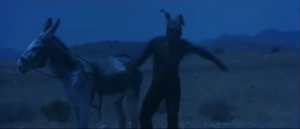
In a crazed dream sequence, safecracker Ray Winstone is menaced (after meeting up with the scary mob boss Ben Kingsley) by a giant bunny hopping off atop a donkey, with a shotgun in tow.
Silent Running
(Douglas Trumbull, 72)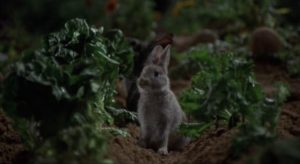 Among the survivors of a smothering Earth is a single rabbit who scurries among the plants being protected by Bruce Dern, as he travels to nowhere in the universe while struggling to protect the last living creatures from a ecologically decimated planet.
Among the survivors of a smothering Earth is a single rabbit who scurries among the plants being protected by Bruce Dern, as he travels to nowhere in the universe while struggling to protect the last living creatures from a ecologically decimated planet.
Song of the South
(dirs. Wilfred Jackson and Harve Foster, 1946)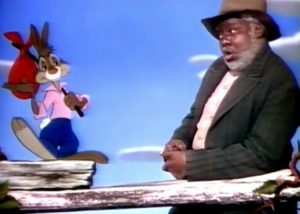
James Baskett, who won a Special Oscar for his role as black author Joel Chandler Harris’ Uncle Remus, interacts with Harris’ sneaky Brer Rabbit in Song of the South, one of the most mystifyingly and controversially repressed movies in cinema history.
Star 80
(dir. Bob Fosse, 1983)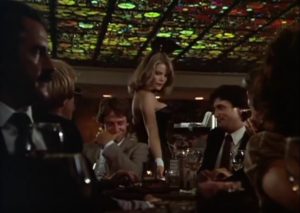
Mariel Hemingway plays the doomed Playboy Playmate Dorothy Stratten in Fosse’s downbeat telling of her career, culminating in her murder by the hands of boyfriend Paul Scheider (Eric Roberts). In this brief scene, she’s seen as a “Bunny” at one of Playboy owner Hugh Hefner’s Playboy clubs.
Twilight Zone: The Movie
(dirs. Steven Spielberg, John Landis, George Miller, Joe Dante, 1983)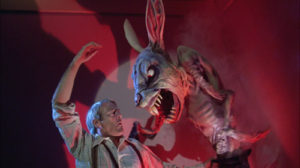
In his remake of Rod Serling’s Twilight Zone episode “It’s a Good Life” (written by Jerome Bixby), in which superhuman kid Billy Mumy terrorizes a group of adults with his out-of-control imagination, director Joe Dante reconfigured things, with the kid’s imaginings of Bugs Bunny being goofed into a horribly mad rabbit chomping at a shaking Kevin McCarthy. The truly scary creatures in this segment were designed by Oscar-winning makeup artist Rob Bottin (Seven, The Thing, Total Recall).
Wallace and Gromit in The Curse of the Were-Rabbit
(dir. Nick Park, 2005)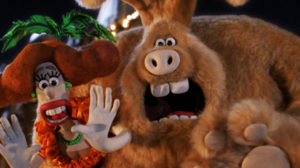
Of course this one has to be in here: the only Oscar-winning movie (for Best Animated Feature) with the word “Rabbit” in its title. Nick Park works this giant, furry villain into his first feature starring goofy inventor Wallace and his resourceful dog Grommit.
Watership Down
(dir. Martin Rosen, 1978)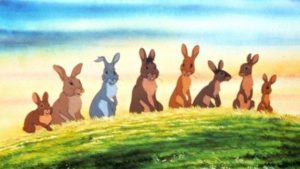
An absolutely most startling visitation of bunnies onto the animation landscape, writer/director Martin Rosen delivered this faithful retelling of Richard Adams’ landmark novel following a troupe of rabbits striving to survive the destruction of their warren. Parents need to be warned against showing this one to their kids–that is, unless their children happen to be extremely astute.
What’s Opera, Doc?
(dir. Chuck Jones, 1957)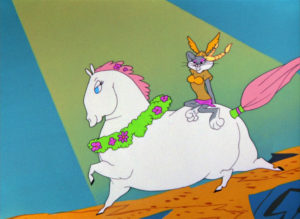
A tribute to Bugs Bunny, the greatest rabbit in movie history, starring in his most superb vehicle, a spoof of Wagnerian opera with Elmer Fudd as the conquering hero and Bugs as his blonde princess.
Who Framed Roger Rabbit?
(dir. Robert Zemeckis, 88)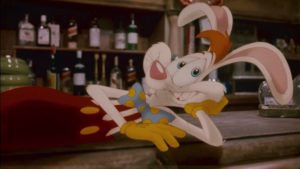
It’s veteran British animator Richard Adams who’s really responsible for the jittery character of Roger Rabbit, a movie star who finds himself at the nasty end of a conspiracy to undermine the public transit system of 40s-era Los Angeles, fought against by private eye Eddie Valient (Bob Hoskins). Roger was voiced by comedian/actor Charlie Fleischer; still, many people remember more vividly the character Jessica Rabbit (voiced by Kathleen Turner), but she wasn’t a rabbit–not by a long shot.
Winnie the Pooh and the Honey Tree
(dir. Wolfgang Reitherman, 1966)
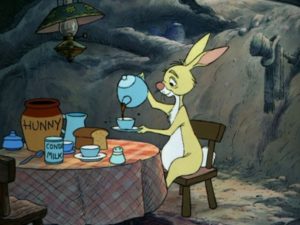
In four of Disney’s Winnie the Pooh shorts, Junius Matthews provided Rabbit’s creaky voice of patience and reason, always slightly exasperated in dealing with hunny-obsessed Winnie the Pooh.
Zootopia
(dirs. Byron Howard and Rich Moore, 2016)

In the Oscar-winning animated tale of mystery and acceptance, Ginnifer Goodwin provides the voice of Judy Hopps, a novice detective in an alternate reality where animals control their own society while struggling to contain their natural instincts.


